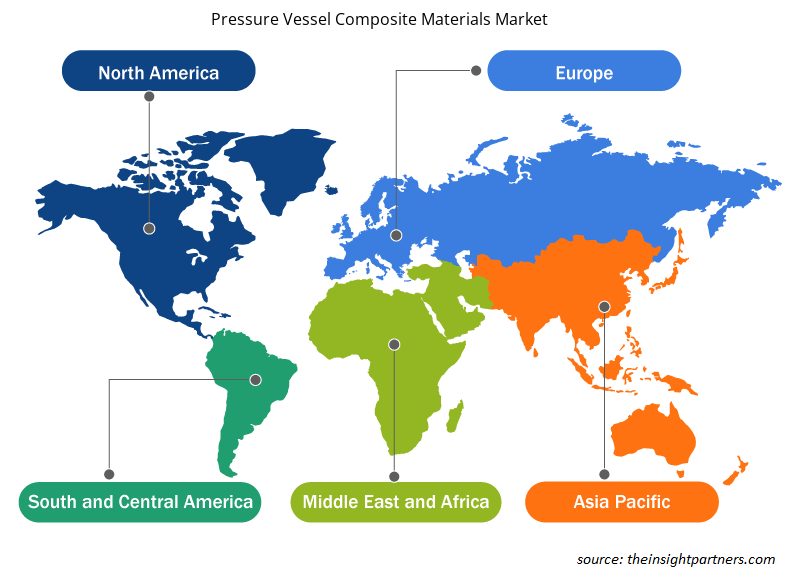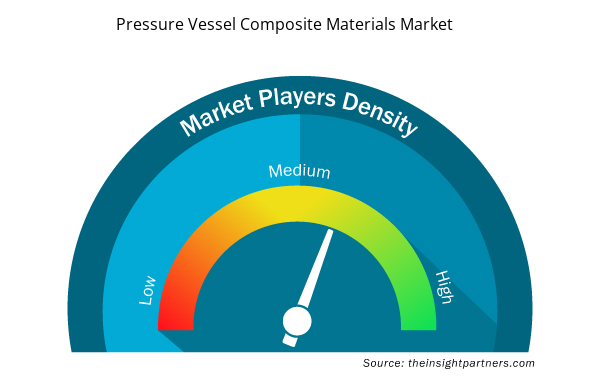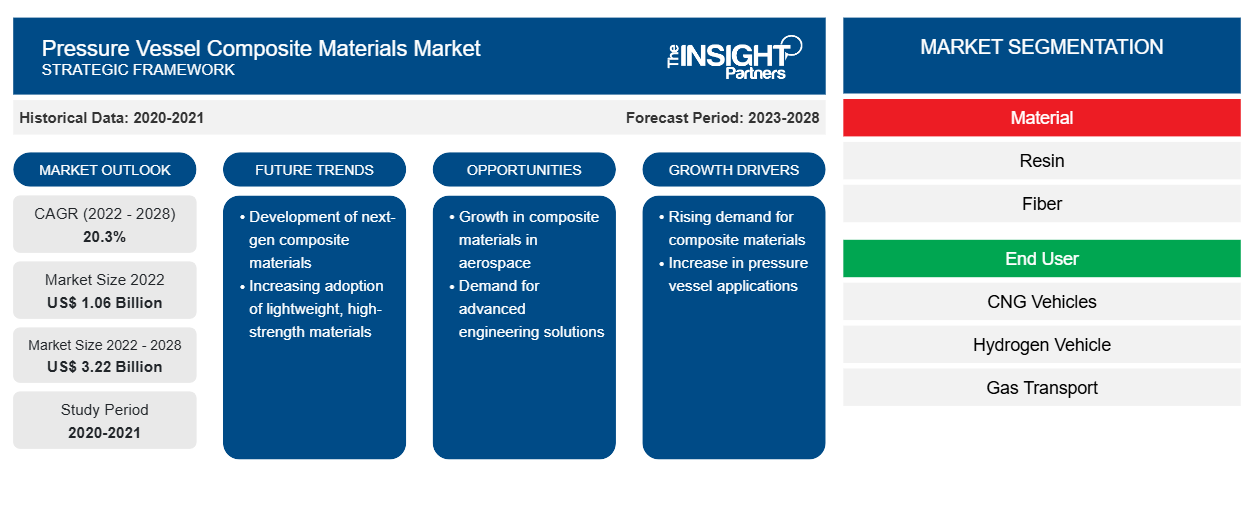من المتوقع أن ينمو حجم سوق المواد المركبة للأوعية المضغوطة من 1،062.63 مليون دولار أمريكي في عام 2022 إلى 3،224.09 مليون دولار أمريكي بحلول عام 2028؛ ومن المتوقع أن يسجل معدل نمو سنوي مركب بنسبة 20.3٪ من عام 2022 إلى عام 2028.
زاد الطلب على المواد المركبة للأوعية المضغوطة بسبب نسبة القوة إلى الوزن العالية. تعمل المواد المركبة للأوعية المضغوطة على تحسين الأداء وتوفر وفورات كبيرة في المواد، مما يدفع نمو السوق. إن القوة الميكانيكية العالية، والصلابة، ومقاومة الطقس، وخصائص الوزن الخفيف للمواد المركبة للأوعية المضغوطة مقارنة بالسبائك المعدنية الأخرى هي التي تدفع الطلب عليها. علاوة على ذلك، أدى ارتفاع الطلب على معدات التبريد والتدفئة إلى تعزيز نمو سوق المواد المركبة للأوعية المضغوطة . توفر المواد المركبة للأوعية المضغوطة مقاومة للتآكل والتلوث المتبادل، مما يسهل استخدامها في الإجراءات الكيميائية المختلفة. كل هذه العوامل تدفع بشكل كبير نمو سوق المواد المركبة للأوعية المضغوطة.
في عام 2021، استحوذت منطقة آسيا والمحيط الهادئ على أكبر حصة من الإيرادات في سوق المواد المركبة للأوعية المضغوطة العالمية. تعد منطقة آسيا والمحيط الهادئ واحدة من الأسواق المربحة للمواد المركبة للأوعية المضغوطة بسبب ارتفاع استخدام أوعية الضغط في صناعة السيارات. تُستخدم أوعية الضغط بشكل أساسي في قطاع السيارات نظرًا لسهولة توفرها وانخفاض تكلفتها. كما أن استخدام المركبات التي تعمل بالغاز الطبيعي المضغوط والهيدروجين بدلاً من المركبات التي تعمل بالوقود التقليدي يعزز نمو سوق المواد المركبة للأوعية المضغوطة في منطقة آسيا والمحيط الهادئ. تعمل المواد المركبة للأوعية المضغوطة مثل راتنجات الإيبوكسي والبلاستيك المقوى بألياف الكربون (CFRP) على تحسين الكفاءة وتوفير التكاليف لمصنعي أوعية الضغط. علاوة على ذلك، تتمتع هذه المواد بخاصية احتواء الضغط العالي، وبالتالي تعزيز تبنيها في سوق منطقة آسيا والمحيط الهادئ.
قم بتخصيص هذا التقرير ليناسب متطلباتك
ستحصل على تخصيص لأي تقرير - مجانًا - بما في ذلك أجزاء من هذا التقرير، أو تحليل على مستوى الدولة، وحزمة بيانات Excel، بالإضافة إلى الاستفادة من العروض والخصومات الرائعة للشركات الناشئة والجامعات
- احصل على أهم اتجاهات السوق الرئيسية لهذا التقرير.ستتضمن هذه العينة المجانية تحليلاً للبيانات، بدءًا من اتجاهات السوق وحتى التقديرات والتوقعات.
تأثير جائحة كوفيد-19 على سوق المواد المركبة للأوعية المضغوطة
شهدت العديد من الصناعات، بما في ذلك صناعة المواد الكيميائية والمواد، تأثيرات سلبية لجائحة كوفيد-19 خلال الفترة الأولية. أعاقت اضطرابات سلسلة التوريد الناجمة عن عمليات الإغلاق والقيود التجارية نتائج التصنيع لمختلف الشركات الكبيرة والصغيرة. كما شهد سوق المواد المركبة للأوعية المضغوطة تأثيرات شديدة للجائحة في عام 2020. وبسبب نقص المواد الخام والعمالة، كانت هناك فجوة واسعة بين الطلب والعرض. علاوة على ذلك، شهدت صناعة السيارات انخفاضًا كبيرًا في الطلب بسبب الركود الناجم عن الوباء، مما أعاق مبيعات المركبات التي تعمل بالغاز الطبيعي المضغوط أو الغاز الطبيعي. أثر هذا العامل بشكل مباشر على الطلب على المواد المركبة للأوعية المضغوطة. ومع ذلك، خلقت مبادرات شركات الأدوية لنقل لقاحات كوفيد-19 فرصًا جديدة لسوق المواد المركبة للأوعية المضغوطة. على سبيل المثال، طورت شركة GPI وعاء ضغط سعة 200 لتر للتسليم السريع للقاحات كوفيد-19 في عام 2020. ومن المتوقع أن تؤدي مثل هذه المبادرات التي اتخذتها الشركات المصنعة إلى دفع سوق المواد المركبة للأوعية المضغوطة.
في عام 2021، شهد السوق انتعاشًا إيجابيًا، حيث أعلنت الحكومات عن تخفيف القيود المفروضة سابقًا. وتم السماح للمصنعين بالعمل بكامل طاقتهم، والاستفادة من ربحيتهم. ومن المتوقع أن يؤدي هذا العامل إلى زيادة نمو سوق المواد المركبة للأوعية المضغوطة على مدى السنوات القادمة.
رؤى السوق
تزايد الطلب على أوعية الضغط من مختلف الصناعات ذات الاستخدام النهائي
تنمو صناعة الكيماويات عالميًا بسبب الاستهلاك المتزايد للسلع مثل الأسمدة وغيرها من المنتجات الزراعية الكيميائية والطلاءات والمواد الماصة وإضاءة LED والبلاستيك والألياف الصناعية والمواد الكيميائية المستخدمة في المختبرات البحثية. ووفقًا للمجلس الدولي للجمعيات الكيميائية (ICCA)، فقد بلغت قيمة صناعة الكيماويات 5.7 تريليون دولار أمريكي في عام 2019، وهو ما يعادل حصة 7٪ في الناتج المحلي الإجمالي العالمي. وبالمثل، تواجه صناعة البتروكيماويات طلبًا متزايدًا من مشاريع البناء المختلفة في جميع أنحاء العالم. تم تصميم أوعية الضغط للعمل عن طريق إدخال الضغط المطلوب لجعل وظيفة التطبيق، مثل الاحتفاظ بالهواء في خزان الغوص. يمكنه توصيل الضغط إما بشكل مباشر عن طريق الصمامات ومقاييس الإطلاق أو بشكل غير مباشر عن طريق نقل الحرارة. تتراوح مستويات الضغط المحتملة من 15 رطل/بوصة مربعة إلى 150000 رطل/بوصة مربعة، في حين تكون درجات الحرارة عادةً أعلى من 400 درجة مئوية (750 درجة فهرنهايت). يمكن لخزان الضغط أن يحمل أي مكان من 75 لترًا (20 جالونًا) إلى عدة آلاف من اللترات. تُستخدم الأوعية المضغوطة في صناعات مختلفة، ولكن ثلاث صناعات تغطي معظم السوق - الصناعات الكيميائية والنفط والغاز والطاقة. يعد النمو في عدد مشاريع الطاقة الصناعية واستبدال الأوعية المضغوطة الحالية أحد العوامل المهمة التي تدفع نمو السوق.
رؤى المواد
بناءً على المادة، يتم تقسيم سوق المواد المركبة للأوعية المضغوطة العالمية إلى راتنج وألياف وغيرها. احتل قطاع الراتينج الحصة الأكبر من سوق المواد المركبة للأوعية المضغوطة العالمية في عام 2021. يستخدم الراتينج أو راتنج الإيبوكسي على نطاق واسع لإنتاج أوعية الضغط. أما بالنسبة لفئة الأوعية، فمن المتوقع أن تشهد الخزانات المركبة المبطنة بالبلاستيك أكبر نمو متسارع على مدار السنوات الخمس المقبلة وكذلك سوق راتنجات الإيبوكسي في هذه الفئة من الأوعية. تستخدم الخزانات المركبة المبطنة بالبلاستيك عددًا أكبر من مركبات الإيبوكسي الكربونية وتوفر أيضًا أقصى قدر من توفير الوزن مقارنة بأنواع أخرى من أوعية الضغط. غالبًا ما يكون شكل الخزان المركب المبطن بالبلاستيك نافذًا، خاصة في حافلات النقل الجماعي والمركبات التجارية المتوسطة والثقيلة. تسمح كثافة الوقود المنخفضة والكتلة المنخفضة لهذه الأوعية بمدى أفضل وكفاءة وقود أفضل للمركبات التجارية المتوسطة والثقيلة، وأيضًا أوقات تشغيل أطول بين محطات التزود بالوقود وتقليل تكاليف الصيانة.
تشمل بعض الشركات العاملة في سوق المواد المركبة للأوعية المضغوطة العالمية شركة 3M Co وBASF SE وHuntsman Corporation وKolon Industries Inc وMitsubishi Chemical Holdings Corp وSolvay SA وZOLTEK Corp وSteelhead Composites Inc وHexion Inc وOlin Corp. يركز اللاعبون في السوق على توفير منتجات عالية الجودة لتلبية طلب العملاء. كما يركزون على استراتيجيات مثل الاستثمارات في أنشطة البحث والتطوير والاندماجات والاستحواذ.
رؤى إقليمية حول سوق المواد المركبة المستخدمة في أوعية الضغط
لقد قام المحللون في Insight Partners بشرح الاتجاهات والعوامل الإقليمية المؤثرة على سوق المواد المركبة للأوعية المضغوطة طوال فترة التوقعات بشكل شامل. يناقش هذا القسم أيضًا قطاعات سوق المواد المركبة للأوعية المضغوطة والجغرافيا في جميع أنحاء أمريكا الشمالية وأوروبا ومنطقة آسيا والمحيط الهادئ والشرق الأوسط وأفريقيا وأمريكا الجنوبية والوسطى.

- احصل على البيانات الإقليمية المحددة لسوق المواد المركبة للأوعية المضغوطة
نطاق تقرير سوق المواد المركبة للأوعية المضغوطة
| سمة التقرير | تفاصيل |
|---|---|
| حجم السوق في عام 2022 | 1.06 مليار دولار أمريكي |
| حجم السوق بحلول عام 2028 | 3.22 مليار دولار أمريكي |
| معدل النمو السنوي المركب العالمي (2022 - 2028) | 20.3% |
| البيانات التاريخية | 2020-2021 |
| فترة التنبؤ | 2023-2028 |
| القطاعات المغطاة | حسب المادة
|
| المناطق والدول المغطاة | أمريكا الشمالية
|
| قادة السوق وملفات تعريف الشركات الرئيسية |
|
كثافة اللاعبين في سوق المواد المركبة للأوعية المضغوطة: فهم تأثيرها على ديناميكيات الأعمال
يشهد سوق مواد الأوعية المضغوطة نموًا سريعًا، مدفوعًا بالطلب المتزايد من المستخدم النهائي بسبب عوامل مثل تفضيلات المستهلك المتطورة والتقدم التكنولوجي والوعي المتزايد بفوائد المنتج. ومع ارتفاع الطلب، تعمل الشركات على توسيع عروضها والابتكار لتلبية احتياجات المستهلكين والاستفادة من الاتجاهات الناشئة، مما يؤدي إلى زيادة نمو السوق.
تشير كثافة اللاعبين في السوق إلى توزيع الشركات أو المؤسسات العاملة في سوق أو صناعة معينة. وهي تشير إلى عدد المنافسين (اللاعبين في السوق) الموجودين في مساحة سوق معينة نسبة إلى حجمها أو قيمتها السوقية الإجمالية.
الشركات الرئيسية العاملة في سوق المواد المركبة للأوعية الضغطية هي:
- شركة 3M
- باسف اس اي
- شركة هانتسمان
- شركة كولون للصناعات
- شركة ميتسوبيشي للكيماويات القابضة
إخلاء المسؤولية : الشركات المذكورة أعلاه ليست مرتبة بأي ترتيب معين.

- احصل على نظرة عامة على أهم اللاعبين الرئيسيين في سوق المواد المركبة للأوعية المضغوطة
تقرير يسلط الضوء على
- اتجاهات الصناعة التقدمية في سوق المواد المركبة للأوعية المضغوطة لمساعدة اللاعبين على تطوير استراتيجيات فعالة طويلة الأجل
- استراتيجيات نمو الأعمال التي تتبناها البلدان المتقدمة والنامية
- التحليل الكمي لسوق المواد المركبة للأوعية الضغطية من 2020 إلى 2028
- تقدير الطلب العالمي على المواد المركبة المستخدمة في أوعية الضغط
- تحليل PEST لتوضيح العوامل السياسية والاقتصادية والاجتماعية والتكنولوجية التي تؤثر على نمو سوق المواد المركبة للأوعية الضغطية العالمية.
- التطورات الأخيرة لفهم سيناريو السوق التنافسي
- اتجاهات السوق وتوقعاتها، فضلاً عن العوامل التي تدفع وتكبح نمو سوق المواد المركبة للأوعية المضغوطة
- المساعدة في عملية اتخاذ القرار من خلال تسليط الضوء على استراتيجيات السوق التي تدعم المصلحة التجارية، مما يؤدي إلى نمو السوق
- حجم سوق المواد المركبة المستخدمة في أوعية الضغط في مختلف العقد
- نظرة عامة مفصلة وتقسيم السوق، بالإضافة إلى ديناميكيات صناعة المواد المركبة للأوعية المضغوطة
- حجم سوق المواد المركبة للأوعية المضغوطة في مناطق مختلفة مع فرص نمو واعدة
نبذة عن الشركة
- شركة 3M
- باسف اس اي
- شركة هانتسمان
- شركة كولون للصناعات
- شركة ميتسوبيشي للكيماويات القابضة
- شركة سولفاي
- شركة زولتيك
- شركة ستيل هيد للمركبات
- شركة هيكسيون
- شركة أولين
- التحليل التاريخي (سنتان)، السنة الأساسية، التوقعات (7 سنوات) مع معدل النمو السنوي المركب
- تحليل PEST و SWOT
- حجم السوق والقيمة / الحجم - عالميًا وإقليميًا وقطريًا
- الصناعة والمنافسة
- مجموعة بيانات Excel


- Health Economics and Outcome Research (HEOR) Services Market
- Authentication and Brand Protection Market
- Third Party Logistics Market
- Frozen Potato Market
- Hot Melt Adhesives Market
- Workwear Market
- Ceramic Injection Molding Market
- Artificial Turf Market
- Sweet Potato Market
- Neurovascular Devices Market

Report Coverage
Revenue forecast, Company Analysis, Industry landscape, Growth factors, and Trends

Segment Covered
This text is related
to segments covered.

Regional Scope
North America, Europe, Asia Pacific, Middle East & Africa, South & Central America

Country Scope
This text is related
to country scope.
الأسئلة الشائعة
The global pressure vessel composite materials market is growing with an upward trend and are extensively being utilized in the space technology domain. This factor is expected to provide lucrative opportunities to the pressure vessel composite materials market.
The major players operating in the global pressure vessel composite materials market include 3M Co, BASF SE, Huntsman Corporation, Kolon Industries Inc, Mitsubishi Chemical Holdings Corp, Solvay SA, ZOLTEK Corp, Steelhead Composites Inc, Hexion Inc, and Olin Corp among few others.
Increasing demand for natural gas-fueled vehicles and increasing demand for pressure vessels from various end-use industries are some of the key driving factors for the pressure vessel composite materials market.
Based on end user, hydrogen vehicles segment is the fastest-growing segment in the pressure vessel composite materials market.
Based on the material, the resin segment accounted for the largest revenue share in 2021 owing to high utilization of resins in manufacturing pressure vessels used in mass transit buses and heavy commercial vehicles.
Asia Pacific accounted for the largest share of the global pressure vessel composite materials market owing to high penetration of CNG vehicles in countries like India and Japan coupled with the presence of well-established automotive industry.
The List of Companies - Pressure Vessel Composite Materials Market
- 3M Co
- BASF SE
- Huntsman Corporation
- Kolon Industries Inc
- Mitsubishi Chemical Holdings Corp
- Solvay SA
- ZOLTEK Corp
- Steelhead Composites Inc
- Hexion Inc
- Olin Corp
The Insight Partners performs research in 4 major stages: Data Collection & Secondary Research, Primary Research, Data Analysis and Data Triangulation & Final Review.
- Data Collection and Secondary Research:
As a market research and consulting firm operating from a decade, we have published and advised several client across the globe. First step for any study will start with an assessment of currently available data and insights from existing reports. Further, historical and current market information is collected from Investor Presentations, Annual Reports, SEC Filings, etc., and other information related to company’s performance and market positioning are gathered from Paid Databases (Factiva, Hoovers, and Reuters) and various other publications available in public domain.
Several associations trade associates, technical forums, institutes, societies and organization are accessed to gain technical as well as market related insights through their publications such as research papers, blogs and press releases related to the studies are referred to get cues about the market. Further, white papers, journals, magazines, and other news articles published in last 3 years are scrutinized and analyzed to understand the current market trends.
- Primary Research:
The primarily interview analysis comprise of data obtained from industry participants interview and answers to survey questions gathered by in-house primary team.
For primary research, interviews are conducted with industry experts/CEOs/Marketing Managers/VPs/Subject Matter Experts from both demand and supply side to get a 360-degree view of the market. The primary team conducts several interviews based on the complexity of the markets to understand the various market trends and dynamics which makes research more credible and precise.
A typical research interview fulfils the following functions:
- Provides first-hand information on the market size, market trends, growth trends, competitive landscape, and outlook
- Validates and strengthens in-house secondary research findings
- Develops the analysis team’s expertise and market understanding
Primary research involves email interactions and telephone interviews for each market, category, segment, and sub-segment across geographies. The participants who typically take part in such a process include, but are not limited to:
- Industry participants: VPs, business development managers, market intelligence managers and national sales managers
- Outside experts: Valuation experts, research analysts and key opinion leaders specializing in the electronics and semiconductor industry.
Below is the breakup of our primary respondents by company, designation, and region:

Once we receive the confirmation from primary research sources or primary respondents, we finalize the base year market estimation and forecast the data as per the macroeconomic and microeconomic factors assessed during data collection.
- Data Analysis:
Once data is validated through both secondary as well as primary respondents, we finalize the market estimations by hypothesis formulation and factor analysis at regional and country level.
- Macro-Economic Factor Analysis:
We analyse macroeconomic indicators such the gross domestic product (GDP), increase in the demand for goods and services across industries, technological advancement, regional economic growth, governmental policies, the influence of COVID-19, PEST analysis, and other aspects. This analysis aids in setting benchmarks for various nations/regions and approximating market splits. Additionally, the general trend of the aforementioned components aid in determining the market's development possibilities.
- Country Level Data:
Various factors that are especially aligned to the country are taken into account to determine the market size for a certain area and country, including the presence of vendors, such as headquarters and offices, the country's GDP, demand patterns, and industry growth. To comprehend the market dynamics for the nation, a number of growth variables, inhibitors, application areas, and current market trends are researched. The aforementioned elements aid in determining the country's overall market's growth potential.
- Company Profile:
The “Table of Contents” is formulated by listing and analyzing more than 25 - 30 companies operating in the market ecosystem across geographies. However, we profile only 10 companies as a standard practice in our syndicate reports. These 10 companies comprise leading, emerging, and regional players. Nonetheless, our analysis is not restricted to the 10 listed companies, we also analyze other companies present in the market to develop a holistic view and understand the prevailing trends. The “Company Profiles” section in the report covers key facts, business description, products & services, financial information, SWOT analysis, and key developments. The financial information presented is extracted from the annual reports and official documents of the publicly listed companies. Upon collecting the information for the sections of respective companies, we verify them via various primary sources and then compile the data in respective company profiles. The company level information helps us in deriving the base number as well as in forecasting the market size.
- Developing Base Number:
Aggregation of sales statistics (2020-2022) and macro-economic factor, and other secondary and primary research insights are utilized to arrive at base number and related market shares for 2022. The data gaps are identified in this step and relevant market data is analyzed, collected from paid primary interviews or databases. On finalizing the base year market size, forecasts are developed on the basis of macro-economic, industry and market growth factors and company level analysis.
- Data Triangulation and Final Review:
The market findings and base year market size calculations are validated from supply as well as demand side. Demand side validations are based on macro-economic factor analysis and benchmarks for respective regions and countries. In case of supply side validations, revenues of major companies are estimated (in case not available) based on industry benchmark, approximate number of employees, product portfolio, and primary interviews revenues are gathered. Further revenue from target product/service segment is assessed to avoid overshooting of market statistics. In case of heavy deviations between supply and demand side values, all thes steps are repeated to achieve synchronization.
We follow an iterative model, wherein we share our research findings with Subject Matter Experts (SME’s) and Key Opinion Leaders (KOLs) until consensus view of the market is not formulated – this model negates any drastic deviation in the opinions of experts. Only validated and universally acceptable research findings are quoted in our reports.
We have important check points that we use to validate our research findings – which we call – data triangulation, where we validate the information, we generate from secondary sources with primary interviews and then we re-validate with our internal data bases and Subject matter experts. This comprehensive model enables us to deliver high quality, reliable data in shortest possible time.


 احصل على عينة مجانية لهذا التقرير
احصل على عينة مجانية لهذا التقرير